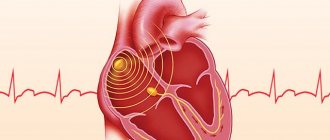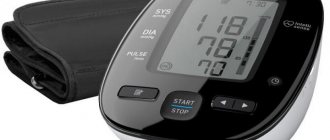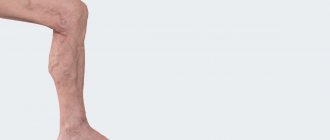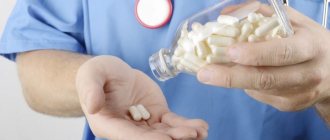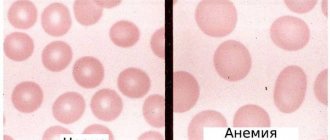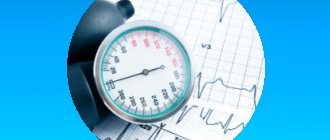Low blood pressure: what is it and why is it dangerous?
General, average indicators indicate that the numbers 120/60 mm given by the tonometer are normal working blood pressure. A decrease of 20% is already considered hypotension. However, each person has his own performance indicators, so the pathological condition is determined based on individual figures, and not on average data.
A significant and sharp decrease leads to oxygen starvation of body cells.
As a result of a decrease in the individual norm, cells throughout the body are no longer supplied with blood saturated with oxygen and nutrients. Various organs begin to work worse, their functionality is impaired. Prolonged oxygen starvation is especially dangerous for the central nervous system and brain. This leads to irreversible consequences and developmental disorders.
There are about 7% of people for whom hypotension is normal and genetically determined. They are relatively efficient and hardy, have a fragile constitution and light skin and hair. When the tonometer readings increase to the average normal values of 120/80, they feel unwell.
Hypotension is diagnosed when the device reading stops at 100/60 or lower. For some, this condition does not cause any discomfort, but most still notice unpleasant signs :
- severe apathy, weakness, fatigue, even after quality rest and prolonged deep sleep;
- decreased concentration;
- pain in the head, usually strong pulsation in the temporal region;
- nausea occurs regularly;
- feeling of dizziness, darkening may be noticed in the eyes;
- chills or sweats;
- your palms and soles may become covered in cold sweat;
- shortness of breath or a feeling of incomplete inspiration when exerting stress on the body.
One or more of these symptoms indicate a disease commonly called hypotension. Experts advise closely monitoring your health, taking regular measurements with a tonometer and studying the question of how to increase your blood pressure.
Low blood pressure, or hypotension, occurs when blood pressure falls below the normal range. This occurs when the systolic (top) value falls below 90 mm Hg and the diastolic (bottom) value falls below 60 mm Hg. Art.
Blood pressure in children can decrease for several reasons. Identifying them will help parents normalize it.
Types of low blood pressure (hypotension) in children
The blood pressure threshold in adults is usually static, but in children it differs depending on age, height and other parameters.
Hypotension can be divided into several categories:
- Orthostatic hypotension : A child's blood pressure drops when he or she stands for long periods of time. Symptoms include headache, weakness, difficulty seeing.
- Neuromediated hypotension : Fainting that occurs when there is an abnormal reflex interaction between the brain and the heart due to a malfunction in the autonomic nervous system. This can happen when the child is in a warm room, stands for a long time, after exercise or after eating.
- Severe hypotension : a significant drop in blood pressure due to severe infection, severe blood loss, severe allergies, or injury.
Low blood pressure in children can be caused by various factors or may be the result of a condition or event.
Causes of low blood pressure in children
Some of the common causes that can lead to low blood pressure in children are:
- Dehydration . Low blood pressure may be one of several symptoms of mild to severe dehydration in children.
- Allergy . A severe allergic reaction (anaphylaxis) can cause low blood pressure.
- Infections . Hypotension may occur in cases of severe infection.
- Iron-deficiency anemia . Low blood pressure may be one of several symptoms of severe iron deficiency anemia in children.
- Heart problems . A drop in blood pressure may be a symptom of heart failure or other heart problems in children. Some other symptoms include breathing problems, excessive sweating and poor development.
- Bruise or injury . The bruise can lead to external or internal blood loss, which can cause a drop in blood pressure. Low blood pressure is often one of many symptoms of severe abdominal trauma that causes internal bleeding.
- Deficiencies of nutrients such as folic acid and vitamin B12 can cause hypotension.
- Problems in the endocrine system (the glands that secrete hormones) can also cause low blood pressure in children.
- Physical stress. Standing or sitting for long periods of time, sun exposure in the summer, intense exercise, and emotionally stressful events can also cause low blood pressure.
Signs and symptoms of low blood pressure in children
A child with low blood pressure is likely to have the following symptoms:
- dizziness or fainting;
- fatigue;
- nausea;
- difficulty concentrating;
- blurred vision;
- nausea;
- labored breathing.
Some people have mild symptoms (headaches and chronic fatigue), which may or may not indicate a drop in blood pressure.
Diagnosis of low blood pressure in children
To diagnose low blood pressure in children, the following procedures are performed:
- Assessing symptoms: The doctor will check for symptoms associated with low blood pressure and may ask parents about any health problems the child has.
- Auscultatory blood pressure measurement: The doctor uses a manual or digital sphygmomanometer to check the baby's blood pressure.
- Pulse detection: Fingers are placed on the artery to feel the pulse. This helps to know the number of heart beats per second.
- ECG: If any abnormalities are found, the doctor may suggest further examination of the heart using an ECG machine.
Treatment of low blood pressure in children
If your blood pressure has dropped due to any medical conditions such as heart problems, infections or allergies, then your doctor may prescribe medications for this.
Low blood pressure in children can often be managed at home when it is caused by physical stress, dehydration or poor diet.
Tips for caring for children with low blood pressure at home
To normalize low blood pressure in a child, follow these measures:
- Foods containing sodium (salty snacks, cured meats, cheese, chicken, soups, breads) may help maintain blood pressure.
- A well-balanced diet is also necessary to maintain blood pressure. The presence of vegetables, fruits and nuts in a child’s daily diet helps restore health. Foods rich in folic acid and vitamin B12 should be included in your regular diet.
- Drinking plenty of fluids helps prevent dehydration, which is one of the causes of low blood pressure in children.
- The child should avoid standing or sitting for too long, especially in a warm room.
- Compression stockings can help maintain optimal blood pressure in the upper body and prevent blood from pooling in the legs.
References:
- Low Blood Pressure in Children; Nicklaus Children's Hospital
- A. Banker, C. Bell, and J. Samuels; Blood pressure percentile charts to identify high or low blood pressure in children; BMC Pediatrics (2016)
- JM Stewart et al.; Pediatric Disorders of Orthostatic Intolerance; Pediatrics Official Journal Of The American Academy Of Pediatrics (2017)
- Patient Information Brochure On Neurally Mediated Hypotension And Its Treatment; Johns Hopkins Hospital (1995)
- M. Zaqqa and A. Massumi; Neurally Mediated Syncope; Texas Heart Institute Journal (2000)
- Low blood pressure; University of Florida Health
- Why is Dehydration so Dangerous?; Rehydration Project
- Food Allergies in Children; University of Rochester Medical Center
- J. Roganović and K. Starinac; Iron Deficiency Anemia in Children; Intech Open (2016)
- Heart Failure in Children and Adolescents; American Heart Association
- Recognizing Internal Injuries in Young Athletes; Stanford Children's Health
- Low Blood Pressure – When Blood Pressure Is Too Low; American Heart Association
- C. Corrado; Blood pressure measurement in children; Italian Journal of Pediatrics (2015)
- Low Blood Pressure: Your guide to symptoms, risk factors, treatment, recovery; Narayana Health
- Low Blood Pressure (Hypotension); Michigan Medicine
- Salt and Sodium; Harvard T.H. Chan
Causes of low blood pressure
The classic reasons for the development of hypotension are considered to be a change in climatic conditions, weather or season, as well as a decrease in body weight, lack of hemoglobin in the blood, and unfavorable working conditions.
Some conditions can cause a sharp drop in blood pressure readings :
- Acute heart failure.
- Brain contusion and concussion.
- An attack of pancreatitis or exacerbation of a gastric ulcer.
- Acute intoxication of the body.
- Overdose of natural heart medications, for example Corvalol, Valocordin and others.
- Taking large doses of antibiotics, antispasmodics or anesthetics.
- With various injuries and blood loss, the pressure will also drop. No less dangerous for hypotensive patients are procedures that dilate blood vessels - visiting a sauna, bathhouse, taking a hot bath, and others.
Children and adolescents suffer from low blood pressure in the event of a violation of vegetative development, for example, during a sharp growth spurt in the child.
Heart pathologies, diabetes mellitus, chronic kidney and adrenal insufficiency can provoke constant hypotension. If you have this condition, it is important to know how to raise your blood pressure at home. To do this, it is worth visiting a therapist, who will most likely prescribe additional examinations from other specialists.
How to quickly normalize blood pressure for an elderly person
Old age often makes itself known not only by wrinkles on the face, but also by low blood pressure. How can an elderly person quickly return their tonometer readings to normal? The first thing that is recommended is to take a shower, and a contrast shower. You can stand under the hot streams of water for a few minutes, then suddenly turn on the cold water.
Read also: Signs of prostatitis in men, how to treat them with folk remedies
The next stage of treatment at home is taking tincture of ginseng or echinacea. You can buy them at any pharmacy and keep them nearby at all times, especially if your blood pressure is unstable. You need to take the medicine in small quantities, only 10 ml shortly before meals.
If you don’t have a tincture, you can get by with a simple tea made from Echinacea flowers. Preparation of the drink:
- grind 20 gr. vegetable raw materials,
- boil 220 ml of water,
- pour boiling water over the echinacea flower paste,
- Close the container tightly and wait a quarter of an hour.
You can drink the prepared medicine in one go, but the treatment will be more effective if you divide the liquid into two parts and drink it with a break of half an hour.
When it's critical
We are talking about calling emergency doctors, which will be required if a person has the following symptoms:
- the skin is sticky and pale, cold to the touch;
- breathing is fast and shallow;
- the pulse is very fast and faintly palpable;
- consciousness is confused, there is no superficial memory.
These symptoms indicate acute arterial hypotension. They occur in cases of collapse or shock. But sometimes they can happen out of nowhere. It is important to know how to quickly raise blood pressure and immediately call an ambulance. Otherwise, hypoxia of the brain and internal organs may develop and can be fatal.
How to raise at home: 7 ways
Unpleasant symptoms of low blood pressure can significantly reduce your quality of life. To prevent this from happening, consult a doctor in time. You need to undergo an examination and know your exact diagnosis. If you can’t see a doctor yet, it’s important to know how to raise your blood pressure at home without medications. There are several proven methods:
- Eat something salty. Any product that can be found in the refrigerator will do: a piece of salty cheese, pickled cucumber, fish or rice flavored with soy sauce. Salt quickly increases blood pressure, but you need to be careful with it. In case of overdose of the product, acute heart failure occurs.
- Drink a glass of water. It will not only help eliminate possible dehydration, but also increase blood volume, expanding the walls of blood vessels. The pressure will quickly return to normal, especially if instead of one glass, a person manages to drink two at once.
- Wear compression garments. Elastic, tight underwear is worn to reduce swelling and pain in varicose veins. If you wear such underwear during hypotension, the blood displaced upward will enter the main vessels and compensate for its lack.
- Take the correct posture. This is an alternative option to compression garments. For example, cross your legs, thus squeezing the flow of blood to the lower extremities. You can put one foot on a chair and lean forward as much as possible. This trick will help equalize the pressure in the body.
- To drink coffee. If you are not a coffee lover and drink the drink quite rarely, you should enjoy strong coffee, because it really raises your blood pressure. Unfortunately, this effect will not happen if a person drinks several cups of coffee per day every day.
- Apply lemongrass tincture. Use a folk remedy of 25 drops 3-4 times a day. This will help establish normal blood pressure readings. You can also use ginseng tincture, eleutherococcus extracts or blades.
- Lead a healthy lifestyle. Exercise and a contrast shower in the morning, visiting the pool, walking in the fresh air, as well as a sound eight-hour sleep are a guarantee of good health and good blood pressure.
When going to the doctor, the patient first of all hears advice about the correct daily routine and quality rest. Massage courses and a set of exercises will not be superfluous.
Ways to quickly increase blood pressure
Low blood pressure is a common abnormality in the functioning of the body, which often occurs not only in adults, but also in adolescents.
It is not always possible to take pills: you may not have a tonometer at hand to accurately find out whether the problem is with your blood pressure, and in case of minor deviations, it is better to eat the right foods or drink a drink that will help than to take medications with side effects. It is important to increase blood pressure promptly and promptly, especially since it is easy even at home.
Why does blood pressure drop?
The cause of low blood pressure is a genetic predisposition, as well as taking medications with a similar side effect: in these cases, deterioration in well-being is expected. For a healthy person, a sharp decrease in blood pressure may come as a surprise, so it is important to know the factors that can trigger changes:
- overwork: physical or mental, because of this even teenagers face the problem;
- depression, stress;
- heart failure;
- weather change, reaction to heat;
- bleeding.
Main symptoms of low blood pressure
If you have a tonometer, it is better to use it to determine the condition. When traveling, on the road or at work, it is not always possible to find out the readings of the device, so you can determine hypotension by the following signs:
- weakness, passivity, apathy;
- drowsiness, desire to rest;
- absent-mindedness, difficulty perceiving what is happening around, inhibited reaction;
- pale skin;
- dizziness, headache, possible mild nausea.
Poor health cannot be ignored: the pressure must be increased. In addition to weakness and decreased performance, the risk of injury due to dizziness increases. The disease affects the functioning of the body: there are disruptions in the functioning of the heart and a lack of oxygen reaching the brain.
The best ways to quickly raise blood pressure at home
If it is not possible to use a tonometer, then it is better not to take risks by self-medicating with medications.
Even with constantly high blood pressure, there is a high probability that a person will develop low blood pressure: in such a situation, taking a pill will further aggravate the condition and lead to the need to go to an ambulance.
We offer effective ways to increase blood pressure at home without risk to health, which work quickly and very effectively.
Treat yourself with delicious drinks
Treatment can be not only useful, but also enjoyable. These few drinks will not only invigorate you, but will also increase blood pressure, improving your well-being and adding strength:
- Tea is the most effective way to cope with illness at home. Not only black, but also green tea is suitable. A freshly brewed thick drink works best: pour one brew and add a little milk to soften the taste and the stress on the body.
- Coffee: real, freshly brewed and strong. This drink is a real salvation for hypotensive people.
- Cognac can be drunk not only on holidays, but also to increase blood pressure. It is important not to exceed the volume of drinking more than 50 grams, otherwise a reverse reaction will be observed in the form of an increase.
- Cola in small quantities will quickly increase blood pressure; gastroenterologists often do not recommend drinking it, but when consumed once, it will not cause more harm than medicine, and is effective.
The drink will help better if you add sugar to it: it will provide the body with glucose, which will improve the person’s general condition.
Making herbal tinctures
Tinctures are of herbal origin, but they also have contraindications and side effects indicated on the box or in the instructions. You need to take the course for about a month to achieve normalization of the condition. The following tinctures are most often used, which can even be found in your home medicine cabinet:
- Do not drink Eleutherococcus tincture before bedtime. Be sure to drink the drug in a course, otherwise a negative effect in the form of insomnia is possible.
- Ginseng tincture perfectly increases blood pressure, and if a person has made a mistake with the diagnosis and already has high blood pressure, then ginseng will not cause harm: it normalizes any deviations.
- Chinese lemongrass is actively used to restore well-being.
What to eat to increase blood pressure
Proper nutrition and adherence to its regime will reduce the risk of disease: you should not skip breakfast and adhere to an overly strict diet. A properly selected menu can significantly reduce risks; besides, tincture, like medicine, cannot always be found at home, but everyone definitely has the products from the list below:
- Salt can cope with the problem: just put a pinch under your tongue and dissolve. You should not abuse this method, because an excess of salt leads to swelling and fluid retention in the body.
- Cinnamon normalizes the condition regardless of deviations of the tonometer readings from the norm, so this spice is universally suitable for hypertensive and hypotensive patients. Pour a glass of boiling water over a teaspoon, and after about an hour add a spoonful of honey.
- Chocolate acts like coffee. Only a real, dark variety without additional impurities is suitable.
- Eggs, dairy products, cheese, fish: all these properly prepared foods will help cope with illness, and if you introduce them into your daily diet, the deterioration of the condition will become rare.
We complement treatment with massage
Massage, like self-massage, is convenient to do at home: it will quickly increase your performance and normalize your condition. The targeted effect should be careful and delicate, without aggressive rubbing or pressing. There are 4 main points to quickly increase blood pressure:
- central part of the back of the head;
- the pad of the little finger (almost its tip);
- the place where the carotid artery is located;
- between lip and nose.
Physical exercise
If you feel very unwell, you need to move carefully, but if the symptoms are not pronounced, then a regular squat will help. After just a few approaches, clarity will appear in your head: the exercise accelerates blood circulation and alleviates the condition. By introducing squats into your daily exercise, you can quickly get rid of low blood pressure.
After you manage to cope with your illness and increase your blood pressure monitor readings, there is no need to return to old habits that cause the disease. Walk more, play sports, sleep at least 8 hours and take a contrast shower. If you often feel unwell, there is no need to get carried away with treatment at home: be sure to see a doctor!
Related Posts
Source: https://mamsy.ru/blog/sposoby-bystro-povysit-davlenie/
Medicines
If a woman or man fails to raise blood pressure at home, and the methods listed above do not bring relief, be sure to make an appointment with a therapist and undergo an examination. After this, the doctor will prescribe medications that can cope with the pathological condition.
Doctors most often prescribe the following drugs:
- Fludrocortisone. It is a synthetic analogue of a hormone produced by the adrenal glands. It stimulates an increase in blood pressure. It is prescribed for conditions known to almost every person. When, getting up from the sofa or bed, your vision suddenly becomes dark and you experience severe dizziness.
- Cordiamin. The drug goes on sale in drops or injections. It has a number of contraindications. Used for hypotension.
- Deoxycorticosterone acetate. It regulates the order of mineral metabolism in cells and tissues and is considered an analogue of the hormone produced by the adrenal cortex. The drug is considered potent, so it is used for severe pathological conditions and the recipe prescribed by the doctor is strictly followed. Otherwise, adverse reactions may occur.
We have presented only a small list of medications that a doctor can prescribe to a patient suffering from hypotension. They may be the answer to a request on how to raise blood pressure at home for an adult. For children, treatment regimens are developed individually.
How to increase lower pressure quickly
It often happens that the upper pressure is normal, but the lower pressure drops to critical levels. What to do in such cases and how to raise lower pressure quickly without the use of pharmaceutical drugs?
Juice squeezed from aloe leaves will help with this problem. There is one trick in using this wonderful plant - the juice obtained not from fresh, but from slightly withered leaves is considered more useful. You can stock up on medicinal raw materials in advance; to do this, pick a few leaves, wrap them in thin polyethylene and put them in the refrigerator.
If there is a sharp jump in lower pressure, it is enough to take out just one leaf, squeeze out the liquid from it (there will be much more of it than when using a fresh leaf) and begin treatment. For one dose, only 15 ml of liquid is enough. There is no need to add anything to it. After an hour, you can consolidate the results - drink another portion of the healing medicine.
Does coffee/tea raise blood pressure?
To some extent, tea raises blood pressure, because it contains a small proportion of caffeine. However, this is not enough to solve pathological conditions. More effective methods are required to bring the tonometer readings to normal and safe levels.
You can take decoctions and herbal infusions instead of tea. They are also brewed to produce a kind of herbal tea. Decoctions of rose hips, black currants, barberry fruits, infusions of dandelion roots, chicory, and black currant leaves will be useful.
In folk medicine there are many ways to raise blood pressure. When asked how to raise low blood pressure, healers give at least a dozen recipes for infusions and decoctions that help eliminate the unpleasant symptoms of illness.
Question answer
Many people suffer from low blood pressure, but not everyone knows about their diagnosis, attributing the pathological condition to increased fatigue, lack of sleep and stress.
You need to see a therapist. It is important to make a clear diagnosis and examine the internal organs that may have been damaged due to the disease. In this case, you most likely cannot do without medications, but only a doctor can prescribe a treatment regimen.
We advise you not to delay your visit to a therapist. He must conduct an examination and identify pathology in order to begin qualified treatment. If this is not yet possible, you can take herbal infusions and streamline your lifestyle to improve its quality. Eat properly and balanced, get quality rest and provide your body with the required physical activity.
We described in detail about methods of dealing with unpleasant symptoms in the article. But you definitely need the help of a local therapist. It is necessary to conduct a full examination and identify all pathologies of the body in order to take comprehensive measures for its treatment.
Bibliography
- E. V. Kudina, V. N. Larina. "Arterial hypotension in the practice of a clinic physician." / Educational and methodological manual for students, residents, graduate students. - M.: Publishing House of the Russian Academy of Medical Sciences, 2016.
- Mikhailov A. A. Chronic arterial hypotension: possibilities of drug correction //Russian. honey. magazine. — 2004.
- Belokon N.A., Osokina G.G., Leontyeva I.V. Vegetative-vascular dystonia in children: clinical picture, diagnosis, treatment (methodological recommendations) // M., 1987.
- Glaurov A.G. Transient disturbances of cerebral circulation in primary arterial hypotension // All-Russian Congress of Neuropathologists and Psychiatrists: Abstracts of reports. - M., 1976.
- Kobalava Zh.D., Kotovskaya Yu.V., Kladiev A.A., Moiseev V.S. Daily blood pressure monitoring in clinical practice. // Clinical pharmacology and therapy. – 1996.
- https://vesti.ua/poleznoe/kak-podnyat-davlenie-v-domashnih-usloviyah


